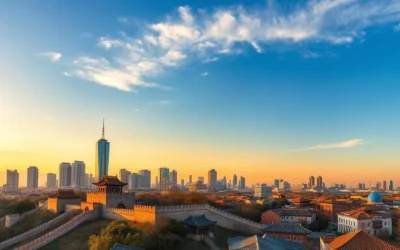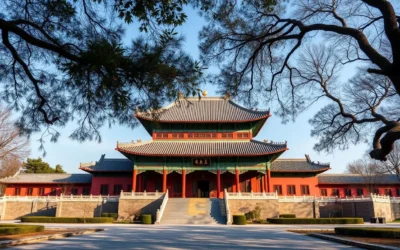✓ Accommodations ✓ Flights ✓ Rental Cars
Step into a world where ancient traditions meet modern celebrations. Jiangsu is a region rich in cultural heritage, offering a unique blend of history and festivity. From grand lantern displays to family reunions, every event tells a story that spans thousands of years.
Festivals here are more than just events; they are a way to connect with the past. Each celebration is a reflection of the region’s deep-rooted traditions. For example, the Lantern Festival, held on the 15th day of the first lunar month, marks the end of the Chinese New Year with over 10,000 lanterns lighting up the night sky.
These festivals are a perfect way to experience the local culture. Whether it’s the vibrant dragon lantern parade or the delicate tangyuan, every detail has meaning. Join us as we explore the unique traditions and cultural significance behind these grand celebrations.
Jiangsu Province, China: Top Festivals to Check Out When Visiting
This region is a place where cultural heritage shines through its festivals. These events are not just celebrations; they are a way to honor the past and bring families together. For centuries, these gatherings have been a cornerstone of community life, connecting generations through shared traditions.
Festivals here are deeply rooted in history, often tracing back thousands of years. For example, the Lantern Festival, also known as the Yuanxiao Festival, has been celebrated since the Han Dynasty. It features over 10,000 lanterns lighting up the night sky, symbolizing unity and hope.
These events are a place for families to reconnect and celebrate their heritage. Whether it’s sharing tangyuan, sweet glutinous rice balls, or watching the dragon lantern parade, every moment is filled with meaning. The artistry and craftsmanship of local artisans are on full display, showcasing the region’s rich cultural legacy.
Communities, both local and international, are drawn to these festivals for their vibrant displays and meaningful customs. Accessibility measures ensure everyone can participate, making these celebrations inclusive and welcoming.
| Festival | Key Feature | Historical Significance |
|---|---|---|
| Lantern Festival | Over 10,000 lanterns | Originated in the Han Dynasty |
| Dragon Boat Festival | Thrilling boat races | Honors poet Qu Yuan |
| Mid-Autumn Festival | Mooncakes and lanterns | Celebrates harvest and reunion |
As you explore these festivals, you’ll gain a deeper appreciation for the region’s history and the role these events play in bringing people together. Stay tuned as we dive into the details of each celebration in the sections ahead.
Dive into the Splendor of the Lantern Festival
Experience the magic of the Lantern Festival, where art and culture come alive. This event marks the vibrant end of the Chinese New Year celebrations, filling the night with mesmerizing displays and interactive experiences. It’s a time when families gather, and communities unite under the glow of thousands of lanterns.
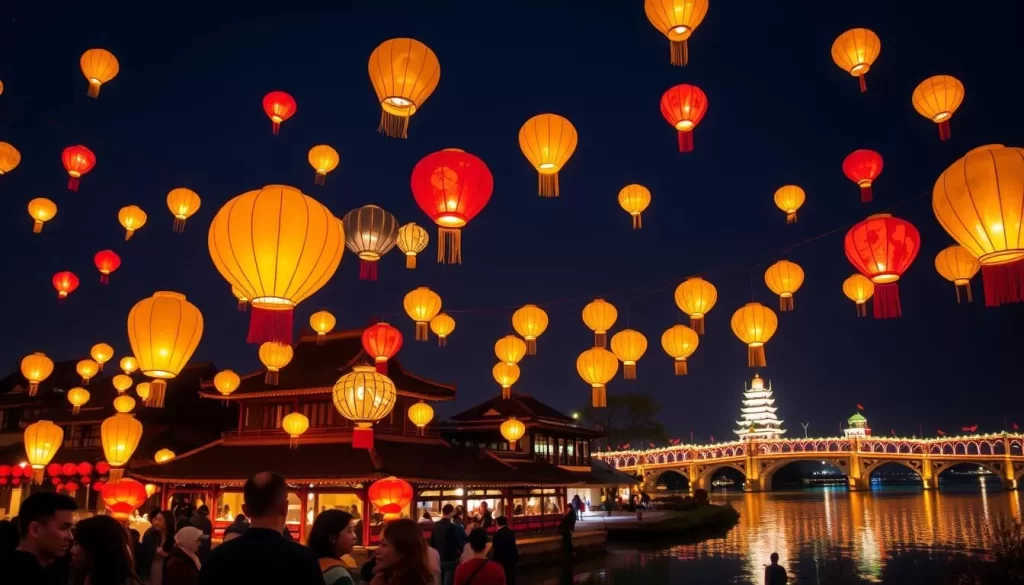
Mesmerizing Lantern Displays and Colorful Lights
As the sun sets, the streets transform into a sea of light. Lanterns of all shapes and sizes illuminate public spaces, creating a breathtaking spectacle. These displays are not just beautiful; they carry deep meaning. Lanterns symbolize reunion, harmony, and prosperity, making them a central part of the festival.
From intricate animal designs to towering structures, each lantern is a work of art. The night sky becomes a canvas, painted with vibrant colors and patterns. It’s a visual feast that captivates visitors of all ages.
Interactive Riddle Games and Cultural Performances
Beyond the lanterns, the festival offers engaging activities. One of the highlights is solving lantern riddles. These puzzles are written on strips of paper attached to the lanterns, challenging your wit and knowledge. It’s a fun way to connect with the culture and traditions of the event.
Traditional performances also take center stage. Dancers, musicians, and storytellers bring the festival to life, showcasing the region’s rich heritage. These acts add another layer of excitement, making the Lantern Festival an unforgettable experience.
Whether you’re admiring the lanterns or solving riddles, this celebration offers a unique blend of art and tradition. It’s a chance to immerse yourself in a culture that values creativity and community. Don’t miss the opportunity to be a part of this magical event.
Celebrate New Beginnings at Chinese New Year
Chinese New Year is a time of renewal, family, and vibrant cultural displays. Known as the Spring Festival, it’s the most important holiday in the lunar calendar. Families reunite, homes are adorned with red decorations, and the air is filled with joy and hope.
Family Reunions, Festive Feasts, and Iconic Traditions
The heart of the celebration is the family reunion dinner. This meal symbolizes unity and prosperity. Dishes like fish and dumplings are served, each carrying a special meaning. Red lanterns and decorations brighten homes, warding off evil spirits and inviting good fortune.
Traditional performances, such as lion and dragon dances, are a highlight. These dynamic shows are celebrated worldwide for their energy and artistry. Fireworks light up the night, marking the start of a new year filled with possibilities.
Modern Celebrations Blended with Ancient Customs
While rooted in history, the festival has embraced modern elements. Digital campaigns and virtual tours have brought the celebrations to a global audience. For example, the @Visit Jiangsu campaign achieved over 580,000 views, showcasing the festival’s enduring appeal.
From ancient rituals to contemporary innovations, Chinese New Year remains a bridge between the past and the present. It’s a time to honor traditions while creating new memories with loved ones.
Honor Traditions with the Qingming Festival
Discover the Qingming Festival, a time of reflection and renewal. This ancient celebration, observed for over 2500 years, combines solemn traditions with the vibrant energy of spring. It’s a moment to honor ancestors, reconnect with family history, and embrace the beauty of nature.
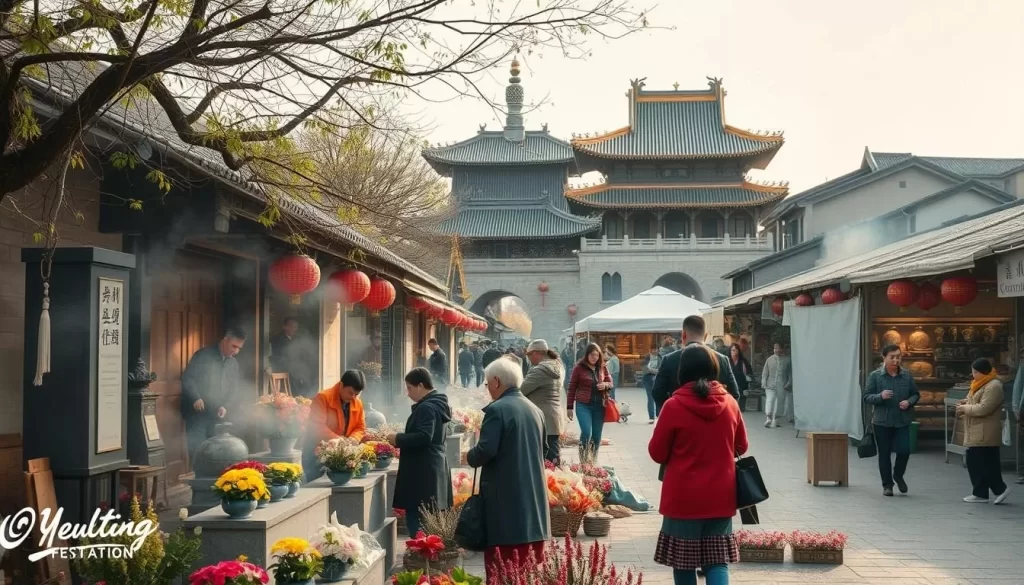
Tomb Sweeping and Ancestral Worship
At the heart of the festival is the practice of tomb sweeping. Families visit ancestral graves to clean and offer sacrifices, such as fruit, liquor, and candies. This ritual, formalized during the Tang Dynasty, symbolizes respect and remembrance. Millions participate annually, with migrant workers often returning home to join in.
Modern adaptations, like online tomb sweeping, have gained popularity. Platforms like Netor.net see over 20 million visits, allowing people to honor loved ones digitally. Whether in person or online, the essence of the tradition remains the same: paying homage to those who came before.
Enjoying the Refreshing Outdoors in Spring
Beyond its solemn aspects, the festival is a celebration of life and renewal. As spring blooms, people take to the streets and visit temples, enjoying the season’s beauty. Outdoor activities like kite flying and playing Cuju, an ancient ball game, are popular.
Willow branches, worn as decorations, are believed to ward off evil spirits and bring good fortune. Families also enjoy traditional foods like qingtuan, sweet glutinous rice balls filled with bean paste. These activities highlight the festival’s dual nature: a respectful remembrance paired with the joy of spring.
| Aspect | Activity | Significance |
|---|---|---|
| Tomb Sweeping | Cleaning graves, offering sacrifices | Honoring ancestors, preserving family history |
| Outdoor Activities | Kite flying, Cuju, enjoying nature | Celebrating life and renewal |
| Traditional Foods | Qingtuan, willow branches | Symbolizing good fortune and cultural heritage |
The Qingming Festival is a beautiful blend of tradition and nature. It’s a time to reflect on the past while embracing the present, making it a truly unique celebration.
Savor the Excitement of the Dragon Boat Festival
Feel the pulse of history and competition at the Dragon Boat Festival. This vibrant celebration, held on the fifth day of the fifth lunar month, combines thrilling races with deep-rooted traditions. It’s a time when communities come together to honor the past and embrace the present.
Thrilling Boat Races Along the River
The heart of the festival lies in its iconic boat races. Teams paddle in unison, their boats shaped like dragons, speeding across the water beneath an open sky. The rhythmic drumming and synchronized movements create a captivating display of skill and teamwork.
These races are more than just a sport; they are a tribute to the ancient poet Qu Yuan. His legacy lives on through this tradition, inspiring participants and spectators alike. The energy of the event is contagious, drawing crowds to riverside parks and scenic spots.
Delicious Zongzi and Time-Honored Customs
No festival is complete without its signature dish. Zongzi, sticky rice dumplings wrapped in bamboo leaves, are a culinary highlight. Each bite is a taste of heritage, symbolizing unity and remembrance.
Families gather to prepare and share these treats, passing down recipes through generations. The festival also features cultural displays, from traditional music to art exhibits, making it a feast for all senses.
| Aspect | Activity | Significance |
|---|---|---|
| Boat Races | Teams paddle in dragon-shaped boats | Honors the legacy of Qu Yuan |
| Zongzi | Making and sharing sticky rice dumplings | Symbolizes unity and heritage |
| Cultural Displays | Music, art, and traditional performances | Celebrates community and history |
The Dragon Boat Festival is a celebration of history, competition, and community. Whether you’re cheering on the races or savoring Zongzi, you’ll find yourself immersed in a tradition that bridges the past and the present.
Experience Romance at the Double Seventh Festival
Immerse yourself in a tale of timeless love at the Double Seventh Festival. Known as the Chinese Valentine’s Day, this event is steeped in ancient legend and celebrated with heartfelt traditions. It’s a time when love stories come to life, blending the past and present in a magical way.
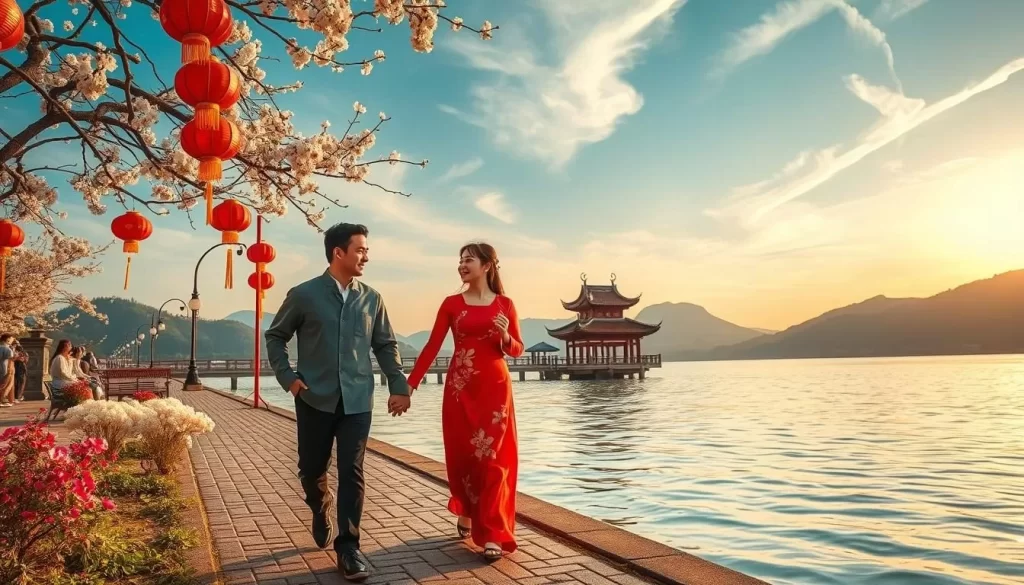
Legends of Love and Mythical Traditions
The festival’s origins trace back to the poignant love story of Niulang, the cowherd, and Zhinu, the weaver girl. Separated by the Milky Way, they are allowed to meet only once a year on the 7th day of the 7th lunar month. This tale has enchanted generations, making the festival a symbol of enduring love.
Traditionally, girls prayed to Zhinu for skillful hands in sewing and sweet love. Today, the festival’s customs have evolved, with modern celebrations focusing on romantic gestures like giving flowers, chocolates, and thoughtful gifts.
Celebrations in Bustling Cities and Serene Countryside
In bustling city settings, the festival is marked by vibrant events like themed performances and romantic dinners. Parks and public spaces are adorned with lanterns, creating a dreamy atmosphere. Meanwhile, in rural areas, traditional practices like crafting symbolic gifts and sharing heartfelt stories are still cherished.
Whether you’re in a lively city or a quiet village, the festival offers a unique way to celebrate love. From enjoying cultural performances to participating in age-old rituals, every moment is filled with meaning.
| Aspect | Activity | Significance |
|---|---|---|
| Legend | Story of Niulang and Zhinu | Symbolizes enduring love |
| Modern Celebrations | Gifts, flowers, and chocolates | Blends tradition with modern romance |
| Traditional Practices | Crafting symbolic gifts | Honors cultural heritage |
Celebrate love and tradition at the Double Seventh Festival. Whether you’re admiring lanterns or sharing heartfelt moments, this event is a beautiful reminder of the power of love.
Reunite with Family During the Mid-Autumn Festival
Celebrate the warmth of family and tradition at the Mid-Autumn Festival. This heartfelt holiday, held on the 15th day of the eighth lunar month, brings loved ones together under the glow of the full moon. It’s a time to reflect on gratitude, unity, and the beauty of shared moments.
Mooncakes, Lanterns, and Heartwarming Reunions
At the heart of the festival is the tradition of sharing mooncakes. These sweet treats, often filled with lotus seed paste or red bean, symbolize unity and completeness. Families gather to enjoy them while admiring the radiant moon, a practice rooted in ancient moon worship.
Lanterns light up the night, creating a magical atmosphere. From intricate designs to towering displays, these lanterns add a festive touch to the celebration. In Beijing, over 200 creative lantern displays, including a 10-meter-tall phoenix lantern, captivate visitors.
Celebrating Under the Radiant Full Moon Sky
The full moon holds deep cultural significance, representing reunion and prosperity. Families often spend the evening outdoors, enjoying the moonlight and participating in activities like lantern riddles and performances. These traditions make the festival a blend of peace and joy.
Modern celebrations have evolved, with cultural and creative mooncakes gaining popularity among young people. This blend of old and new ensures the festival remains relevant while honoring its roots. To learn more about the unique customs of this celebration, explore Mid-Autumn Festival traditions.
Whether you’re sharing mooncakes or admiring lanterns, the Mid-Autumn Festival offers a chance to reconnect with loved ones and embrace the beauty of tradition. It’s a holiday that celebrates family, gratitude, and the magic of the moonlit night.
Embrace the Resilience of the Double Ninth Festival
Celebrate resilience and honor the wisdom of elders at the Double Ninth Festival. This ancient event, observed on the ninth day of the ninth lunar month, is a beautiful way to connect with seasonal traditions and pay respect to senior citizens. It’s a time to reflect on life’s cycles and embrace the strength of past generations.
Mountain Climbing and Chrysanthemum Displays
One of the most iconic activities during the festival is mountain climbing. Families and friends gather to hike, symbolizing the pursuit of higher goals and overcoming challenges. The crisp autumn air and stunning views make it a memorable experience.
Chrysanthemum displays are another highlight. These vibrant flowers, known for their resilience, are showcased in gardens and public spaces. They represent longevity and vitality, aligning perfectly with the festival’s themes.
Traditional Foods and Culinary Delights
No celebration is complete without its signature food. Chongyang Cake, a steamed pastry, is a must-try during the festival. Its layers symbolize growth and prosperity, making it a meaningful treat to share with loved ones.
Other dishes, like chrysanthemum wine, are also enjoyed. This fragrant drink is believed to promote health and well-being, adding another layer of significance to the festivities.
- Mountain climbing symbolizes resilience and ambition.
- Chrysanthemum displays celebrate longevity and beauty.
- Chongyang Cake and chrysanthemum wine are traditional foods that enhance the celebration.
The Double Ninth Festival is a unique way to honor the past while embracing the present. Whether you’re climbing a mountain or enjoying a slice of Chongyang Cake, you’ll find yourself immersed in a tradition that celebrates life’s enduring spirit. To learn more about this meaningful event, visit this link.
Explore the Enigma of the Hungry Ghost Festival
Uncover the secrets of the Hungry Ghost Festival, a time when the spiritual and physical worlds intertwine. This unique event is steeped in mystery and tradition, offering a glimpse into ancient beliefs and practices. It’s a celebration that honors the unseen and ensures harmony between the living and the dead.
Nighttime Rituals, Offerings, and Spiritual Legends
As the sun sets, communities come alive with nighttime activities aimed at appeasing wandering spirits. Offerings of food, incense, and paper money are placed outside homes and temples. These rituals are believed to provide comfort to the spirits and prevent misfortune.
One of the most fascinating aspects is the burning of joss paper, symbolizing wealth for the afterlife. This activity is deeply rooted in Taoist beliefs and reflects the festival’s spiritual significance. Families also light lanterns to guide spirits back to their realm, creating a mesmerizing event that blends tradition with beauty.
Balancing Tradition with Superstitious Customs
The festival is a delicate balance of reverence and caution. Many avoid swimming or staying out late, believing it could attract unwanted spirits. These superstitious customs have been passed down through generations, adding layers of intrigue to the event.
At its core, the Hungry Ghost Festival is a time to honor ancestors and maintain harmony. It’s a legend that continues to evolve, blending ancient practices with modern interpretations. Whether you’re participating in the rituals or observing from afar, this event offers a unique way to connect with cultural heritage.
- Nighttime activities include offerings and lantern lighting to guide spirits.
- Burning joss paper symbolizes wealth for the afterlife, rooted in Taoist beliefs.
- Superstitious customs, like avoiding late-night outings, add intrigue to the festival.
To learn more about the spiritual traditions of this region, visit Religion in China. The Hungry Ghost Festival is a captivating event that highlights the enduring connection between the living and the spiritual world.
Revel in Patriotism on China’s National Day and Labor Day
Feel the pulse of national pride during China’s most iconic public holidays. National Day and Labor Day are more than just breaks; they are vibrant celebrations of unity and heritage. These events bring communities together in a shared atmosphere of joy and patriotism.
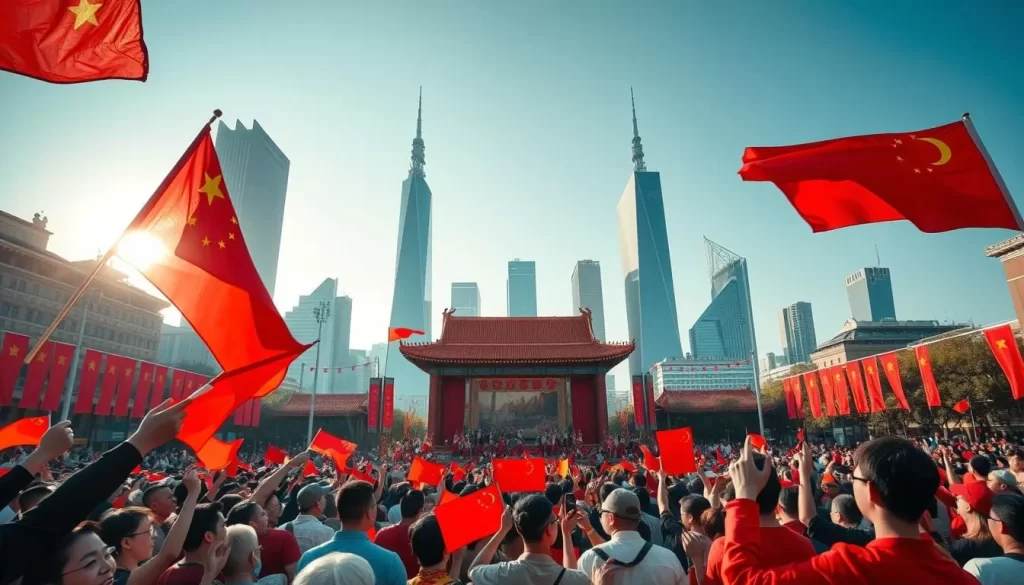
Grand Fireworks, Public Celebrations, and Cultural Parades
One of the highlights of these holidays is the grand fireworks displays. The night sky lights up with dazzling colors, creating a magical atmosphere that captivates everyone. Public celebrations, including colorful parades and concerts, add to the festive spirit.
These events are not just about entertainment; they tell a story of national pride and communal unity. Each parade and performance reflects the rich cultural heritage and modern achievements of the country. It’s a trip into the heart of what makes these holidays so special.
A Celebration of Unity and Heritage
National Day and Labor Day are one important way to honor the country’s history and progress. Families and friends gather to enjoy the festivities, creating memories that last a lifetime. The sense of togetherness is palpable, making these holidays a true reflection of community spirit.
Visitors from around the world are drawn to these celebrations, each with their own story to share. Whether you’re watching the fireworks or joining a parade, you’ll feel the energy and pride that define these events. It’s a trip that offers both entertainment and a deeper understanding of modern culture.
To learn more about the cultural significance of these holidays, explore this link. These celebrations are one important way to connect with the heart of a nation and its people.
Conclusion
From vibrant lantern displays to solemn ancestral rites, these events offer a unique glimpse into a culture that spans generations. Each celebration tells a story of unity, resilience, and the enduring beauty of traditions passed down through time.
Whether it’s the lively boat races or the serene moonlit gatherings, every festival is a show of cultural pride. The natural landscapes provide a stunning backdrop, enhancing the beauty of these events. These celebrations are not just for locals; they invite visitors to connect with a country’s rich heritage.
Plan your trip to explore these cultural marvels. Witness how history and nature intertwine in every celebration. Let these festivals inspire you to embrace the traditions that have shaped a generation.
The above is subject to change.
Check back often to TRAVEL.COM for the latest travel tips and deals.

